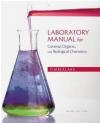Laboratory Manual for General, Organic, and Biological Chemistry
Karen Timberlake
Laboratory Manual for General, Organic, and Biological Chemistry
Karen Timberlake
- Producent: Prentice Hall
- Rok produkcji: 2013
- ISBN: 9780321811851
- Ilość stron: 432
- Oprawa: Miękka
Niedostępna
Opis: Laboratory Manual for General, Organic, and Biological Chemistry - Karen Timberlake
The Laboratory Manual for General, Organic, and Biological Chemistry, third edition, by Karen C. Timberlake contains 35 experiments related to the content of general, organic, and biological chemistry courses, as well as basic/preparatory chemistry courses. The labs included give students an opportunity to go beyond the lectures and words in the textbook to experience the scientific process from which conclusions and theories are drawn.
Preface To the Student Using This Laboratory Manual Working Safely in the Laboratory Commitment to Safety in the Laboratory A Visual Guide to Laboratory Equipment Graphing Experimental Data Using the Laboratory Burner Using a Pipet 1 Measurement and Significant Figures A. Measuring Length B. Measuring Volume C. Measuring Mass 2 Conversion Factors and Problem Solving A. Rounding Off B. Significant Figures in Calculations C. Equalities and Conversion Factors D. Problem Solving Using Conversion Factors 3 Density and Specific Gravity A. Density of a Liquid B. Specific Gravity C. Density of a Solid D. Graphing Mass and Volume 4 Temperature and Specific Heat A. Temperature B. Specific Heat of a Metal C. Energy and Nutrition D. Energy Values for Foods 5 Energy and Matter A. A Heating Curve for Water B. Graphing a Cooling Curve for Salol C. Energy in Changes of State: Heat of Fusion 6 Atoms and Elements A. Elements and Symbols B. The Periodic Table C. The Atoms D. Isotopes and Atomic Mass 7 Electronic Configuration and Periodic Properties A. Flame Tests B. Electron Configurations C. Atomic Radius 8 Nuclear Chemistry A. Nuclear Equations B. Radiation Measurement C. Radiation Levels from Radioactive Sources D. Effect of Shielding on Radiation Level E. Effect of Time on Radiation Level F. Effect of Distance on Radiation Level 9 Compounds and Their Bonds A. Ions: Transfer of Electrons B. Ionic Compounds and Formulas C. Metals in Ionic Compounds with Variable Charge D. Polyatomic Ions E. Molecular Compounds F. Electron-Dot Formulas and Molecular Shape 10 Chemical Reactions and Equations A. Magnesium and Oxygen B. Zinc and Copper (II) Sulfate C. Reactions of Metals and HCl D. Reactions of Ionic Compounds E. Sodium Carbonate and HCl F. Hydrogen Perioxide 11 Moles and Chemical Formulas A. Finding the Simplest Formula B. Formula of a Hydrate 114 12 Gas Laws A. Boyle's Law B. Charles's Law 13 Dalton's Law of Partial Pressures A. Partial Pressures of Oxygen and Nitrogen in Air B. Carbon Dioxide in the Atmosphere C. Carbon Dioxide in the Expired Air 14 Solutions, Electrolytes, and Concentration A. Polarity of Solutes and Solvents B. Electrolytes and Nonelectrolytes C. Electrolytes in Body Fluids D. Concentration of a Sodium Chloride Solution 15 Soluble and Insoluble Salts A. Soluble and Insoluble Salts B. Solubility of KNO3 C. Testing the hardness of Water D. Purification of Water 16 Testing for Cations and Anions A. Flames Tests for K+ , Ca2+ , and Na+ Ions B. Tests for Ammonium Ion, NH4+ , and Iron(III) Ion, Fe3+ C. Tests for Negative Ions (Anions) D. Writing the Formula of Your Unknown Salt E. Testing Consumer Products for Some Cations and Anions 17 Properties of Solutions A. Identification Tests B. Osmosis and Dialysis C. Filtration 18 Reaction Rates and Chemical Equilibrium A. Factors That Affect the Rate of a Reaction B. Chemical Equilibrium: Reversible Reactions C. Changing Equilibrium Conditions: Le Ch(R)telier's Principle 19 Acids, Bases, pH and Buffers A. Reference Colors for pH Using Red Cabbage Indicator B. Measuring pH C. Effect of Buffers on pH 20 Acid-Base Titration A. Acetic Acid in Vinegar B. Titration of an Antacid 21 Organic Compounds: Alkanes A. Comparison of Organic and Inorganic Compounds B. Alkanes C. Functional Groups 22 Reactions of Unsaturated Hydrocarbons A. Types of Unsaturated Hydrocarbons B. Addition Reaction: Bromine Test C. Oxidation: Potassium Permanganate (KMnO4 ) Test D. Identification of Unknown 23 Alcohols and Phenols A. Structures of Alcohols and Phenol B. Properties of Alcohols and Phenol C. Oxidation of Alcohols D. Ferric Chloride Test E. Identification of Unknown 24 Aldehydes and Ketones A. Structures of Some Aldehydes and Ketones B. Odor of Aldehydes and Ketones C. Solubility, Iodoform Test, and Benedict's 25 Carboxylic Acids and Esters A. Carboxylic Acids and Their Salts B. Esters C. Saponificiation 26 Aspirin and Other Analgesics A. Preparation of Aspirin B. Testing Aspirin Products C. Analysis of Analgesics 27 Amines and Amides A. Structure, Classification, and Solubility of Amines B. Neutralization of Amines with Acid C. Amides D. Hydrolysis of an Amide 28 Synthesis of Acetaminophen Synthesis of Acetaminophen 29 Types of Carbohydrates A. Monosaccharides B. Disaccharides C. Polysaccharides 30 Tests for Carbohydrates A. Benedict's Test for Reducing Sugars B. Seliwanoff's Test for Ketoses C. Fermentation Test D. Iodine Test for Polysaccharides E. Hydrolysis of Disaccharides and Polysaccharides F. Testing Foods for Carbohydrates 31 Lipids A. Physical Properties of Lipids and Fatty Acids B. Triacylglycerols C. Bromine Test for Unsaturation D. Preparation of Hand Lotion 32 Saponification and Soaps A. Saponification: Preparation of Soap B. Properties of Soap and Detergents 33 Amino Acids A. Amino Acids B. Chromatography of Amino Acids 34 Peptides and Proteins A. Peptides B. Proteins C. Denaturation of Proteins D. Isolation of Casein (Milk Protein) E. Color Tests for Proteins 35 Enzymes A. Effect of Enzyme Concentration B. Effect of Temperature C. Effect of pH D. Inhibition of Enzyme Activity
Szczegóły: Laboratory Manual for General, Organic, and Biological Chemistry - Karen Timberlake
Tytuł: Laboratory Manual for General, Organic, and Biological Chemistry
Autor: Karen Timberlake
Producent: Prentice Hall
ISBN: 9780321811851
Rok produkcji: 2013
Ilość stron: 432
Oprawa: Miękka
Waga: 0.98 kg






























